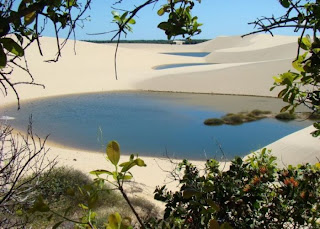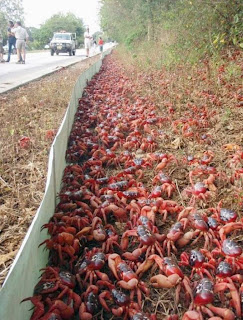The Lencois Maranhenses National Park is located in Maranhao state, in northeastern Brazil, just east of the Baía de Sao Jose. It is an area of low, flat, occasionally flooded land, overlaid with large, discrete sand dunes.
Wonderful Ocean Animal
Friday, 13 April 2012
Tuesday, 6 March 2012
Red Crab Migration
At the beginning of the wet season (usually October / November), most adult red crabs suddenly begin a spectacular migration from the forest to the coast to breed. Breeding is usually synchronized island-wide. The rains provide moist overcast conditions for crabs to make their long and difficult journey to the sea. 07 more images after the break..
The easiest places to watch the crab migration and the females spawn are at Drumsite, Flying Fish Cove, Ethel Beach and Greta Beach.
Updates on public notice boards and local radio give crab movements during the migration.The annual breeding migration.
While the rains provide the moist preconditions for the march to begin, the timing of the migration breeding sequence is also linked to the phases of the moon. Eggs are released by the female red crabs into the sea precisely at the turn of the high tide during the last lunar quarter.
The sea level at the base of the cliffs and on the beaches, where the females release their eggs, at this time varies the least for a longer period, and it is therefore safer for the females approaching the water's edge to release their eggs. Sometimes there are earlier and later migrations of smaller numbers of crabs but all migrations retain this same lunar rhythm.
Males lead the first wave of the downward migration and are joined by females as they progress. Larger males arrive at the sea first (after about five to seven days) but are soon outnumbered by females. The crabs replenish moisture by dipping in the sea.The males then retreat to the lower terraces to dig burrows. The density of burrows is high (one to two per square metre) and males fight each other for burrow possession. The females move to the terraces and mating occurs. After mating, males dip again and begin returning inland.
The females produce eggs within three days of mating and remain in the moist burrows on the terraces for 12-13 days while they develop. The eggs are held in a brood pouch between their extended abdomen and thorax. A single female can brood up to 100,000 eggs. In the morning and late afternoon around the last quarter of the moon, the egg-laden females descend from the terraces to the shoreline. They pack into shaded areas above the waterline, in densities of up to 100 per square metre in some places. The females usually release their eggs into the sea toward dawn, around the turn of the high tide. Release of eggs may occur on five or six consecutive nights during the main breeding migration.
Wednesday, 19 October 2011
Colorful Marine Life Of Indonesia
Vittoria Amati photographs the marine life
around the coral reefs of Sulawesi, Indonesia
These underwater photos offer a unique
glimpse of the sea - they have been turned
into negatives. British photographer
Vittoria Amati, 54, transformed her photographs
using computer software to appear
like x-rays. Above a black-saddled sharpnose fish
The photographs taken up to 30 metres
below the surface at the Bunaken
Marine Park, North Sulawesi, Indonesia reveal
creatures such as coral, fish and crabs in
stunning detail. (Star fish, Gomophia watsoni)
Vittoria accidently turned one of her underwater
photographs into a negative and, pleased with the
transformation, decided to do the same with
her collection of 45 images. (Banggai cardinal fish)
Vittoria, from London, said: "I stumbled
across a negative version of one of my
images and became really excited - they
had the power to trigger the imagination
. I was stunned, it was as if I was looking
at my photos for the first time." (Sea anemone)
"I used photo editing software to turn the
images into negatives, then worked on
changing the colours layer by layer.
I needed to restrain myself to keep
the effect 'natural'. If the viewer is used
to see a coral red I turned it into blue,
making things opposite."
(A strap-weed filefish, Pseudomonacanthus macrurus)
"There was the odd problem,
" explains Vittoria, "the first time
I went diving I forgot to take the lens off my
camera, but eventually everything
came together." (Echinothrix calamaris)
(Red soft coral and brittlestar)
The images were taken mainly during the
day but also at night when a lot of life comes
out feeling more protected by the dark.
(A Nembrotha species)
"Swimming with fish is incredibly pleasant,
there is an extraordinary beauty hidden under the waves.
" (Coral grouper)
"The aim is to show people how beautiful
every marine organism is, even the tiniest.
The sea is not only about big fish and mammals
like whales, sharks and dolphins. The sea is an
environment very rich in biodiversity.
" (Sea urchin, Diademasavignyi)
Tuesday, 4 October 2011
Subscribe to:
Comments (Atom)
















